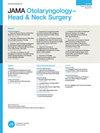Human auditory nerve action potentials and brain stem evoked responses.
引用次数: 220
Abstract
Latency-intensity (L-i) functions for (1) the auditory nerve action potential (AP) N1 peak, (2) the brain stem evoked response (BER) V peak, and (3) the N1-V interval were related to hearing level and lesion location. The AP L-l curves tended to steepen with increasing 4 to 8 kHz hearing level. This relationship was identical for cochlear and retrocochlear ears, except for a few retrocochlear ears with "inappropriate AP perservation." Both high-frequency cochlear loss and retrocochlear abnormality prolonged peak V latency, but retrocochlear abnormality generally prolonged it more. Among cochlear-loss ears, as 4 to 8 kHz hearing levels increased, N1-V intervals decreased and L-i curve slopes increased. In contrast, retrocochlear abnormality greatly prolonged N1-V intervals. As a retrocochlear sign, N1-V prolongation was slightly more reliable than V prolongation.人听神经动作电位和脑干诱发反应。
(1)听神经动作电位(AP) N1峰、(2)脑干诱发反应(BER) V峰和(3)N1-V间期的潜伏期-强度(L-i)功能与听力水平和病变部位相关。随着4 ~ 8 kHz听力水平的升高,AP L-l曲线逐渐变陡。这种关系在人工耳蜗和后耳蜗中是相同的,除了少数“不适当的AP保留”的后耳蜗。高频耳蜗丢失和耳蜗后异常均可延长V峰潜伏期,但耳蜗后异常一般更能延长V峰潜伏期。在耳蜗损失耳中,随着4 ~ 8 kHz听力水平的增加,N1-V间隔减小,L-i曲线斜率增大。相反,耳蜗后异常大大延长了N1-V间期。作为耳蜗后征象,N1-V延长比V延长更可靠。
本文章由计算机程序翻译,如有差异,请以英文原文为准。
求助全文
约1分钟内获得全文
求助全文

 求助内容:
求助内容: 应助结果提醒方式:
应助结果提醒方式:


